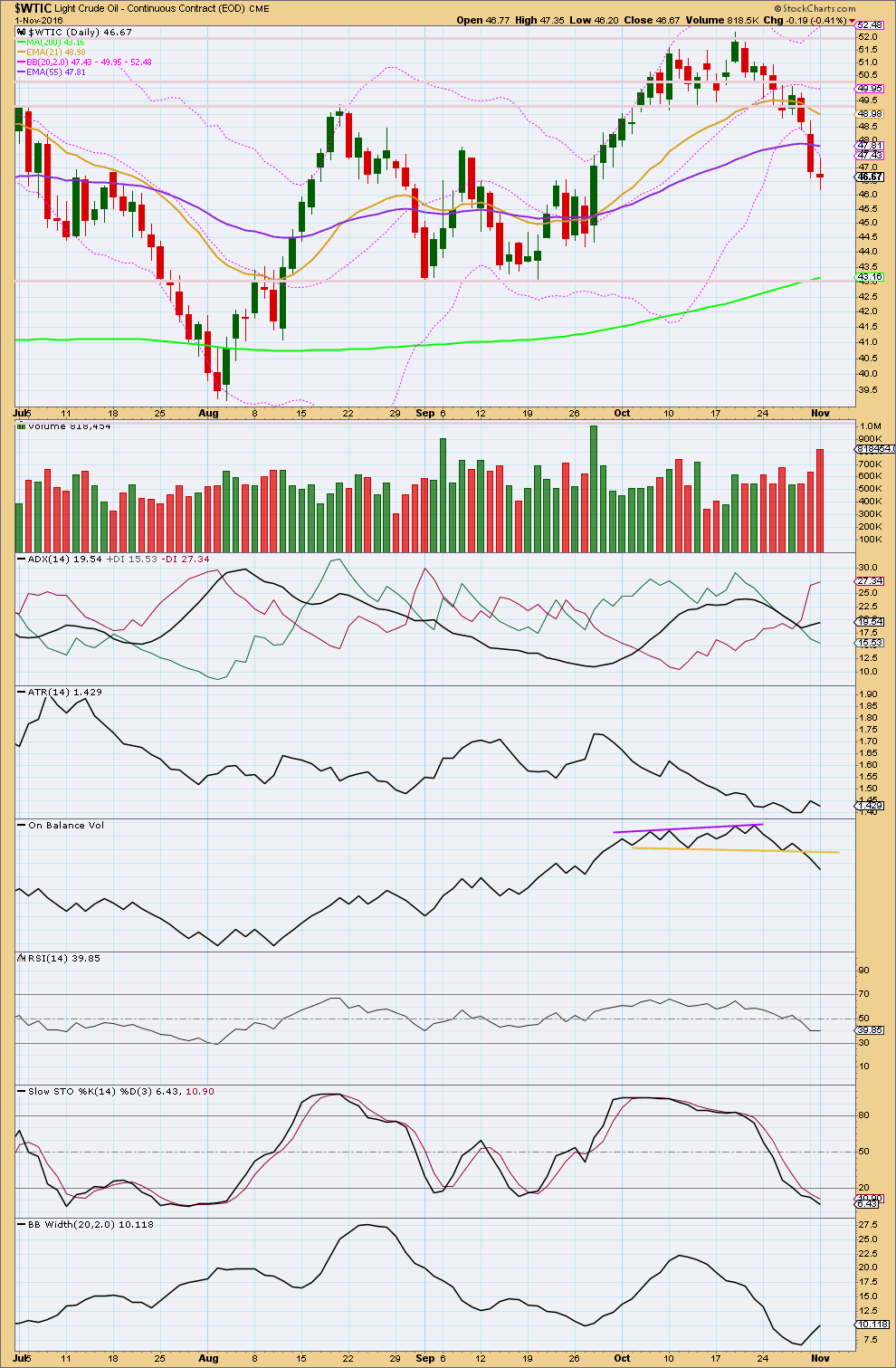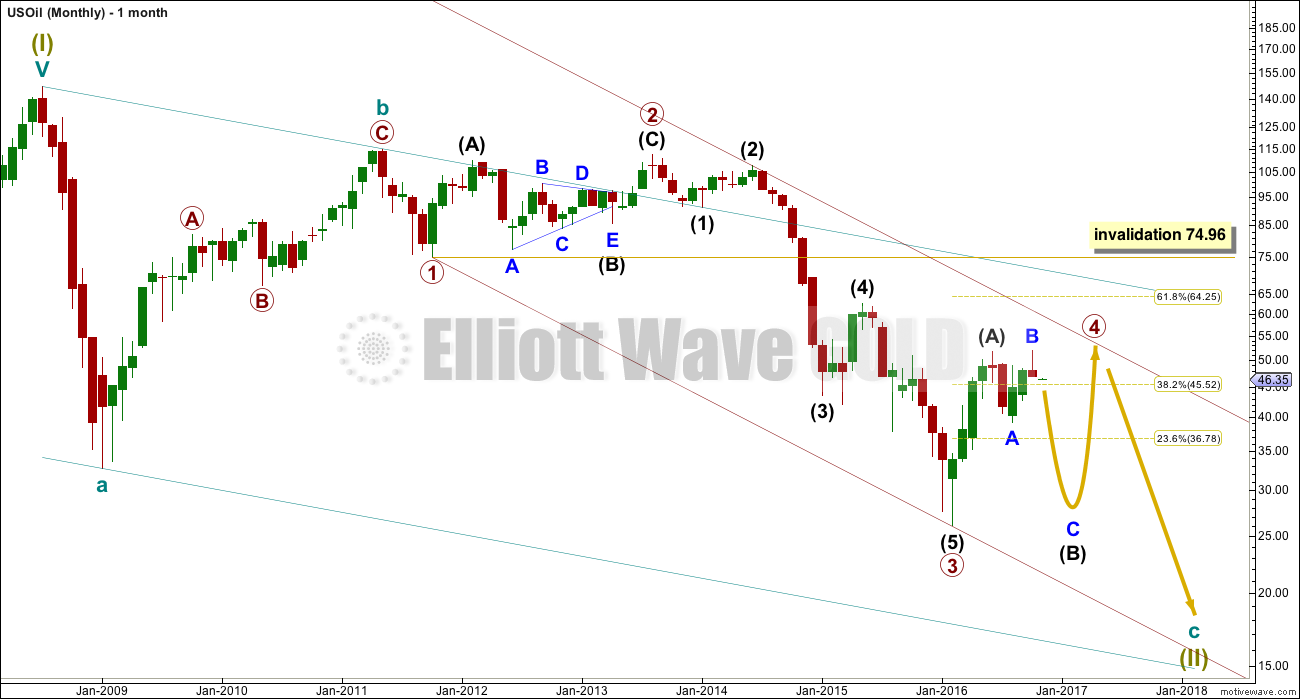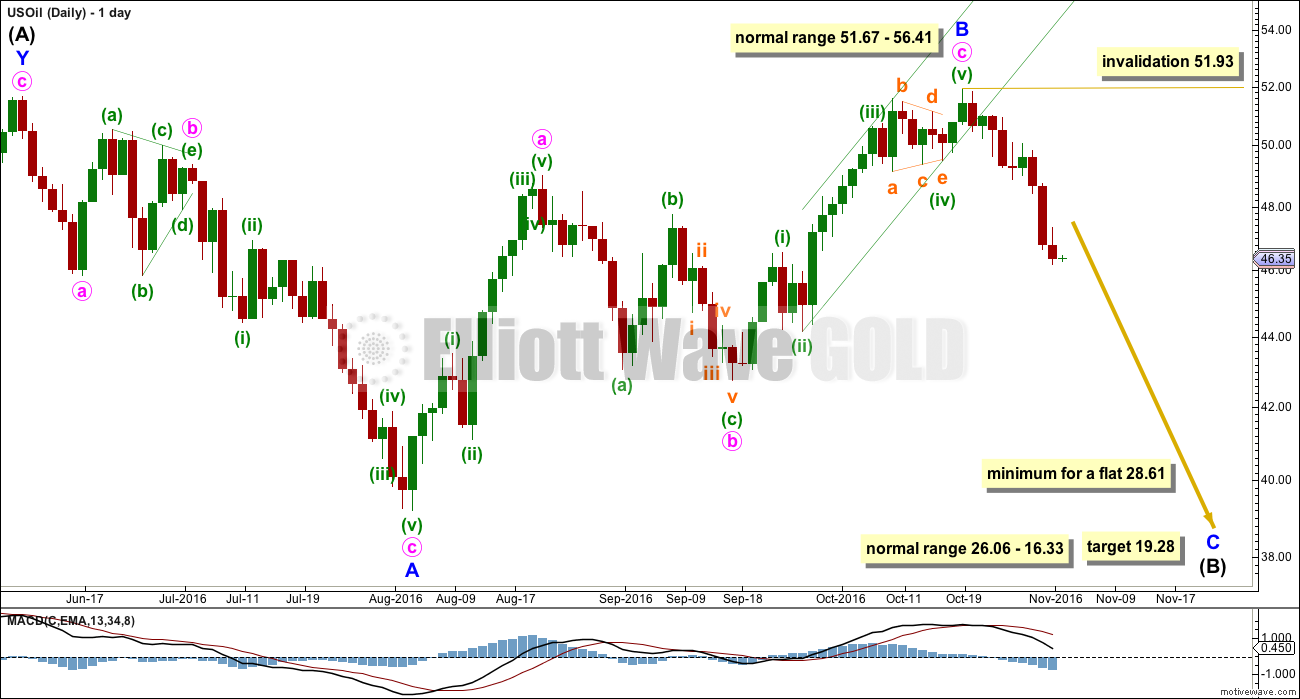Last week the US Oil Elliott wave and classic technical analyses were in agreement that there had been a trend change for Oil.
Downwards movement was expected. This is what happened.
Summary: The target for the next wave down is at 19.28. Downwards movement is supported by volume.
New updates to this analysis are in bold.
MONTHLY ELLIOTT WAVE COUNT
Within the bear market, cycle wave b is seen as ending in May 2011. Thereafter, a five wave structure downwards for cycle wave c begins.
Primary wave 1 is a short impulse lasting five months. Primary wave 2 is a very deep 0.94 zigzag lasting 22 months. Primary wave 3 is a complete impulse with no Fibonacci ratio to primary wave 1. It lasted 30 months.
Primary wave 4 is likely to exhibit alternation with primary wave 2. Primary wave 4 is most likely to be a flat, combination or triangle. Within all of these types of structures, the first movement subdivides as a three. The least likely structure for primary wave 4 is a zigzag.
Primary wave 4 is likely to end within the price territory of the fourth wave of one lesser degree; intermediate wave (4) has its range from 42.03 to 62.58.
Primary wave 4 may end if price comes up to touch the upper edge of the maroon channel. The upper edge of this channel has been pushed up to sit on the end of intermediate wave (2) within primary wave 3.
Primary wave 4 is most likely to be shallow to exhibit alternation in depth with primary wave 2. So far it has passed the 0.382 Fibonacci ratio at 45.52. It may now continue to move mostly sideways in a large range.
Primary wave 4 may not move into primary wave 1 price territory above 74.96.
DAILY ELLIOTT WAVE COUNT
Intermediate wave (A) fits neatly as a double zigzag. This is classified as a three.
Intermediate wave (B) now looks like may have completed as an expanded flat correction. This is also classified as a three.
When both A and B waves subdivide as threes, the larger structure one degree higher is either a flat or triangle. Within a triangle though, no part of intermediate wave (B) should move beyond the end of intermediate wave (A) above 51.67. A new high above 51.67 may eliminate a possible triangle unfolding at this stage for primary wave 4.
Primary wave 4 looks like it may be unfolding as a flat correction if my analysis of intermediate wave (A) is correct.
Within a flat correction, the minimum depth for intermediate wave (B) is 0.9 the length of intermediate wave (A) at 28.61. Intermediate wave (B) may make a new price extreme beyond the start of intermediate wave (A) below 26.06 as in an expanded flat.
Intermediate wave (B) is unfolding as a flat correction. Within intermediate wave (B), minor wave B is a completed zigzag structure. Minute wave c is a complete impulse and downwards movement has breached the Elliott channel drawn about it in green.
Minor wave B is a 1.02 length of minor wave A. This would indicate a regular flat correction. Minor wave B has ended within the normal range of 1 to 1.38 times the length of minor wave A, from 51.67 to 56.41.
Normally, the length for minor wave C would be expected to be about equal with minor wave A, but this would not bring price down to the minimum requirement one degree higher for intermediate wave (B) to be 0.9 the length of intermediate wave (A) at 28.61.
The ratio used to calculate the target is 2.618 the length of minor wave A at 19.28.
Within minor wave C downwards, no second wave correction may move beyond the start of its first wave above 51.93.
TECHNICAL ANALYSIS
DAILY CHART

Click chart to enlarge. Chart courtesy of StockCharts.com.
Price moved lower for the last three days in a row on increasing and strong volume. The fall in price is supported by volume. This supports the Elliott wave count.
However, Oil sometimes ends its waves with strong and increasing volume. While volume does support the Elliott wave count, it is not certain that price must keep falling here.
On Balance Volume has given a reasonable bearish signal with a break below the yellow support line. This supports the Elliott wave count.
ADX is above 15 and increasing. The -DX line is above the +DX line. ADX indicates a downwards trend is in place.
ATR indicates some cause for concern as it is not clearly increasing. This trend does not have a normal increasing range.
Bollinger Bands are widening. Volatility has returned to this market.
With two of these indicators in agreement that there is a downwards trend, it is reasonable to conclude downwards movement is likely to continue.
The next support line is about 43.10.
RSI is not extreme. There is room for price to continue lower.
Stochastics is now oversold, but this oscillator may remain extreme for reasonable periods of time during a trending market. It does not indicate any divergence yet with price to indicate weakness for bears.
This analysis is published @ 08:51 p.m. EST.



I feel like doing a little happy dance today….
“Go oil! Go oil! Go oil!”
Keeping a keen eye out for weakness in this move… and I’ll post a comment and / or chart as soon as I think it’s time to bail on shorts.
Still not seeing enough signs of weakness in Oil. Holding short position over the weekend.